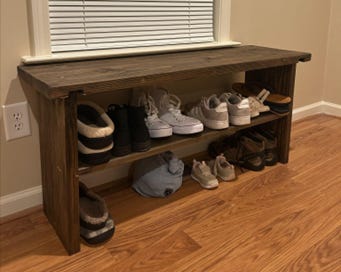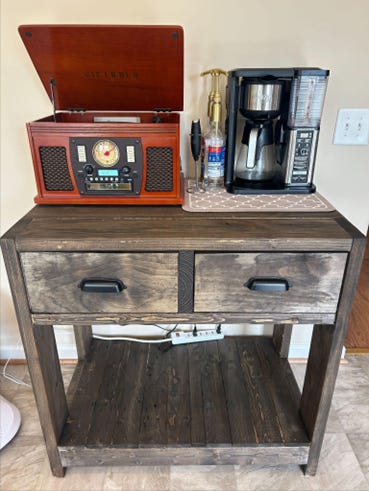By guest author Right Of Normie.
I had just gotten home from work, walked through the front door, and added my shoes to the ever-growing pile. “We really need a shoe rack,” I thought to myself. So I did what any hardworking American would do: I sat on my couch, pulled out my phone, and searched Amazon for “shoe racks.”
Immediately, I was bombarded by such well-known, reputable brands as FILWH, VTRIN, and SONGMICS. Being the shrewd businessman I am, I purchased the first result and awaited my package.
The following day, upon returning home, I was greeted by a welcome sight: an Amazon box. I grabbed it, went inside, added my shoes once again to the slightly larger pile, and set to work. When I opened the box, I was less than thrilled. Cheap plastic clips, thin aluminum tubes, papier-mâché shelving, and instructions written in such poor English I needed a translator to decipher them.
That’s when I paused and looked around. Every piece of furniture I owned was of similar quality. Our entertainment system — ordered on a Prime Day “deal” — was made of MDF particle board, laminated with a woodgrain sticker pretending to be “authentic finish.” Our end tables required precision placement of anything on top to avoid wobble.
I thought back to my grandmother’s house. As a child, I remembered how imposing her furniture felt — the craftsmanship, the weight, the beautiful finish. In contrast, my own furniture was a hodgepodge of imposters. And I thought to myself once more: “It doesn’t have to be like this.”
That was the moment I decided my family would have quality, handmade, generational furniture.
There was just one problem: the only power tool I had ever used was a hand drill — while installing curtain rods — and that usually ended in frustration and a few choice words.
So again, I did what any American would do: I went on YouTube and searched “how to make a shoe rack.”
The results were immediate — and overwhelming. But about five minutes into each video, without pause, the narrator would turn and walk into a fully outfitted workshop. Armed with only a circular saw and a power drill, I started to feel out of my league. I nearly gave up.
But then I was hit with a realization: you can just build things.
So once again, I Googled “rustic shoe racks,” found some inspiration, and set my course. I jumped into my RAV4 (yes, not a truck, but a RAV4) and headed to Lowe’s.
I spent more time than I’d like to admit wandering the aisles of Lowe’s, Googling everything: What is S2S wood? S4S wood? What’s the best wood for furniture? Can you use pine? How do you stain? How do you sand? Best screws for furniture? What does a #10 screw mean?
In the end, I left with my supplies:
Lumber – about $30 worth
Hardware (screws, nails, stain opener) – about $25
Pre-stain + stain – around $30
Total: about $100. But since the screws and stain have lasted through several projects, it’s been a good investment.
Back home, I was eager to get started. I’ll spare you the detailed play-by-play of the build, but I’ll share the result:
It may not look like much, but for me and my family, it’s everything. We now have a solid, aesthetically pleasing, handmade shoe rack that will last a lifetime. In raw material, adjusting for hardware used only in this build, it cost approximately $50–$60 to make. Compare that to any “real wood” furniture online or in your local home goods store, and the cost savings are clear.
After that first project, I was hooked. What started as a leap of faith — a frustrated search for a decent shoe rack — quickly became something much more. I found myself learning new techniques, researching tools, and fielding requests from my wife like I’d suddenly become Tim Allen. Our family now has a growing list of things we want to make together — not just for ourselves, but for our kids, and maybe even for their kids one day. What began as a weekend experiment turned into a lifelong passion.
Our most recent project:
I’ll admit — I already owned a few of the big-ticket tools. But for any of you just starting out, they can easily be found on Facebook Marketplace, thrift stores, or yes — even Amazon itself.
You don’t need a truck. Just a trunk and some tie-downs to bring lumber home.
I don’t write this as a humblebrag, but as encouragement. You can just build things.
You can make real, authentic, handmade pieces for your friends and family. You really can just build things.










You can do most anything with a power drill and second-hand table saw. Consignment shops and estate sales (thanks boomers) are your friend.
I've been wanting to get into building our own furniture. The issue is I live in an apartment, and don't have the space to store tools or make a mess.